The early days
At a Christmas tree function at Tenindewa in 1950, I agreed to go share farming with Dave Heelan on his farm named Ajax. The farm was named after a famous Australian bred champion race horse also named Ajax that won 18 consecutive races before he was defeated at the odds of 40/1 on, causing a huge racing sensation. The agreement was that I would supply the labour and a third of the running costs and in return, be provided with a third of the profits. Dave would supply the land, seed, super and machinery. A hand shake sealed the agreement and remained that way for the rest of my 37 years at Ajax.
I started farming on Ajax in January 1951. Dave and I lived in a three room house which had been shifted there from the goldfields. It was very basic living with a big rain water tank being the only water supply. Water on the farm was very scarce. Dave had a very silty bore on a newly purchased block that was also salty. He had 260 sheep and had to cart a lot of water from a government bore close by.
It wasn’t uncommon to have to pull pipes up on the silty bore as the buckets would jam and break the wooden rods. Dave said that the first 5, 000 miles clocked up on his new truck was from driving backwards pulling pipes out of the silty bore.
Bill is the Father of Neil and Brien the now owners of Ajax, Archie Olman later farmed at Mendal.
Clearing the land
For the first four years on the farm I did some scrub rolling to clear the land on McRoberts block and on the Green block (see map of Ajax). I used a Lanz tractor with rubber tyres (similar to one illustrated) and fitted two big steel rims over the front tyres that was wide enough to flatten anything that may puncture the rear tyres. This worked well as I had little trouble with punctures.
I have vivid memories of being jolted out of the seat and onto the radiator of the tractor when I hit something big on one occasion. So I always stood up on the tractor when rolling for I am sure if I had sat in that seat I would have been rocketed to the moon as the seat had a big coil spring underneath it. Every year I cleared the land for approximately 6 months and then worked for Dave for the other six months. When I was not share farming, I was clearing the land.
In 1954 Dave went on a four months sailing tour of Europe. It was a well deserved trip as he had worked long and hard on the farm and had also worked on the mines in the great depression. He was always grateful to get another start at farming with the help of his sisters Nell and Tess.
Luckily for me Dave had a great little dual wave radio that was good company while he was away. I could pick up any country station in the world. I even picked up the Flying Doctor station at times. There was one problem. The radio was powered by a two volt wet battery that had to be sent to Geraldton every six weeks to be charged, leaving me without a radio for a week at a time.
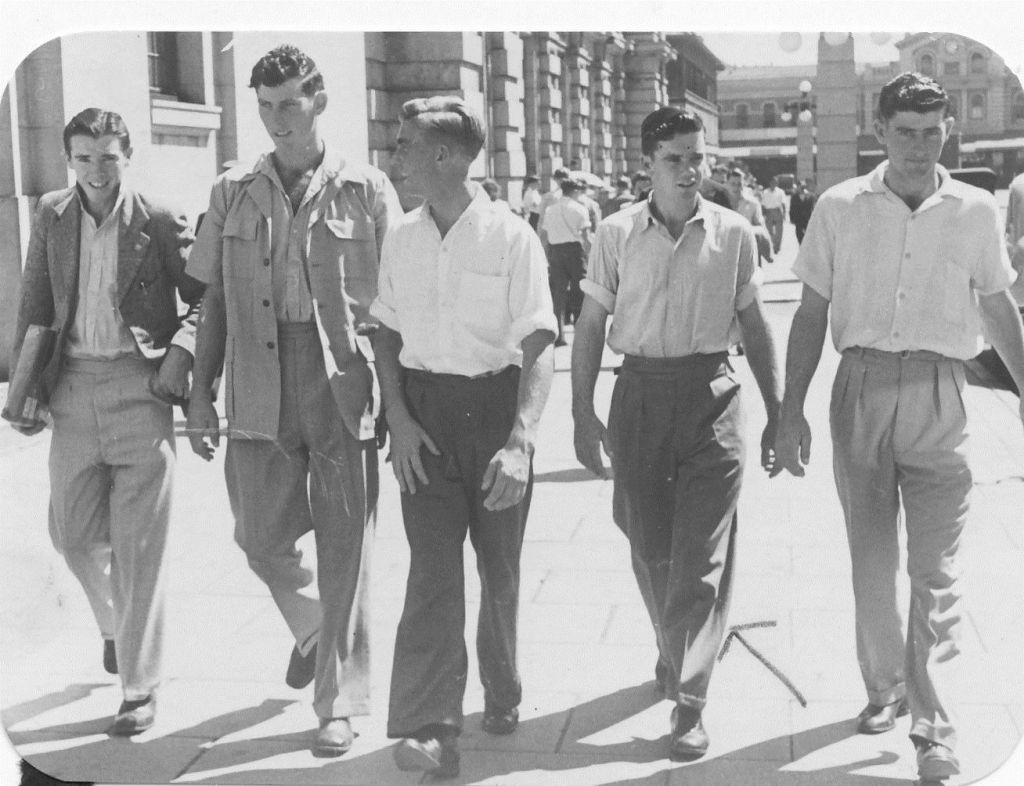
Keith Butler, Jack Brenkley, Bill Cox, Albert Cream, Doug Brenkley (a rare shopping day in Hay St Mall, Perth)
Ned Higgins
I remember driving in Dave’s Bedford truck to the Tenindewa Store to get the mail. Although the truck was new, it had bad headlights, and also when you put your foot on the brake it would lock up one wheel and you seemed to go faster. One incident I recall with that truck and the Higgins’s was when I got to the lane-way between Ryan’s and Hayes’ place, I ran through a ring lock fence (which had been “strung up” temporarily and illegally) and thankfully just stopped short of a mob of sheep!! Ned Higgins owned the place adjacent at that time and he had fenced 3 000 sheep there for the night. A big tall man came toward me to see what I was doing. He approached me and held a hurricane lamp about six inches from my nose. It turned out to be Ned’s father. I had heard a lot of stories about Ned’s father and, had I known it was him coming towards me, I would have been somewhere else. To my surprise he was quite pleasant and helped me put the fence back up. When I asked him what he was doing with the sheep, he told me ‘the mob was Ewes and Wethers mixed’ and the next day Ned was going to ‘put them in the paddock and chase them until the wethers hit the front’. He would then split them into two mobs- “not perfect but near enough”.
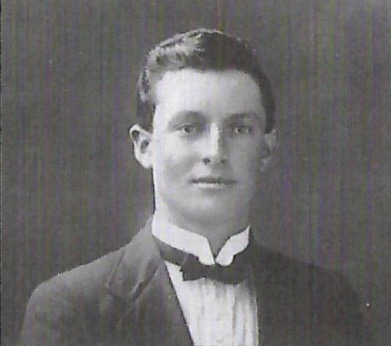
Ned Higgins aged 21
I first met Ned Higgins when I was about 17 yrs old when he came to Eradu to dig for coal. Ned had just rescued a Catalina Flying boat off a reef in Geraldton. This is well documented in other stories. Ned’s work at the mine saw him raising poppet legs over the mine site. These poppet legs supported a big wheel for the wire ropes to run over when pulling the soil from the mine. From memory Ned would stand on top of the first two poppet legs, which were previously erected using a tractor, and then he would bolt the other poppet legs in when they were raised. With a 14 lb hammer he drove big bolts through the timbers to complete the job. It was an amazing effort for one man to do. At different times other men helped him. I remember some of these men as being his brother Kevin Higgins, Joe Jefferies and Neil Mitchell (of boxing fame).

The remnants of Ned’s mine in the early 60s
The mine was just over the road from my family’s home. Chess Morrow was also mining for coal 200 yards further down the road. Ned and Chess competed with each other and the race was on to see which could get to the coal first. I think they only had to dig to a depth of 120 ft, but water was a big problem. Between the two mines they pumped 120 000 gallons of water an hour. Ned put steel cylinders down the shaft and pumped cement behind them to try and stop the flow of water.

Ned’s mine. Note Alberts family home in the background. There is a huge tele-communication tower on this spot now
Ned and Chess Morrow struck coal the same day. It had taken months of hard work but they had achieved their goal. The Minister for Mines was to arrive by train to inspect their work. Chess waited at the station in Mullewa for his arrival while Ned jumped into his car and met him in Geraldton. We had a lot to do with Ned and his team while they were there and sometimes his wife Sylvia would come to visit him at the mine. We all thought of her as being a lovely woman. Ned was a strongly built man and looked quite handsome when he put his ‘town togs’ on. I remember him getting into his car to go to Geraldton. He would pull the cigarette lighter from the dashboard of his car and plug in a shaver so he could have a shave on the way. This gave him five extra minutes of time before leaving to go to Geraldton.
Although machines were hard to come by, Ned seemed to get them. I had a ten disc plough compared to Ned who had 3 x10 disc ploughs. He turned these into a 30 disc plough by pulling them behind a huge crawler tractor. I also remember seeing Ned’s sons, Tim and Des, harvesting on Ned’s property but I did not have much to do with them. I met them one weekend when they were taking two girls out to see their farm. One of the girls, Merle, later became Des’ wife.

One of the Higgins rigs in the early 60s. A TD14 with at least 2 X seeders behind

The Mullewa Road Board with some wonderful old identities
I remember an encounter with Ned in Geraldton when I was driving from Durlacher Street into Marine Terrace. I was met by Ned who was driving his big AEC semi truck and travelling in the opposite direction. He stopped me and between the both of us we had completely blocked the traffic, not that the traffic was very busy those days and no one seemed to mind, least of all Ned. He climbed onto the back of his semi to uncover 2 lovely watermelons and handed them to Jean as he thought she “would enjoy them”.

Higgin’s AEC Semi delivering the Tenindewa Hall. It was formally a RAAF building from the Geraldton Airport
Later Ned went on to becoming a Councillor in the Mullewa shire. George Eves, another shire Councillor and prominent farmer told me a story about Ned in the Mullewa Bowling club one night. George told me he had gone to Perth one time with Ned to a shire conference and stayed with Ned and Sylvia. Ned and George had just started having a drink out on the veranda while the evening meal was being prepared when the phone rang. Ned went to answer it and George waited and waited for Ned’s return for a long time before knocking on the front door. When Ned opened the door he was aghast as he realised he had forgotten George was there. He was apparently very apologetic and Sylvia was ashamed. George told me that night at the Bowling Club “Creamy, Ned is a good man but I won’t go with him again. I couldn’t keep up with him.”
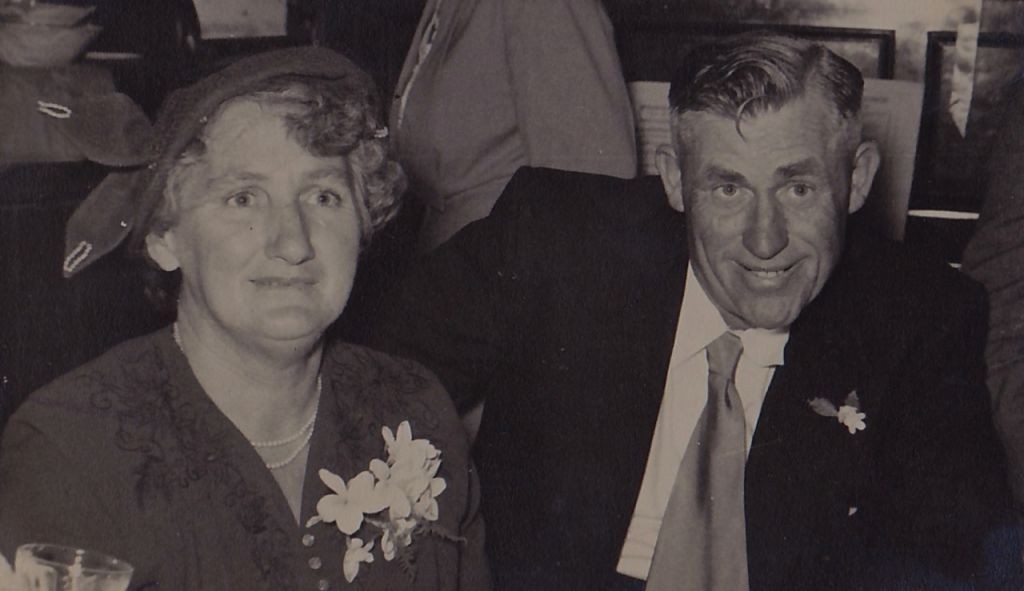
Grace and George Eves
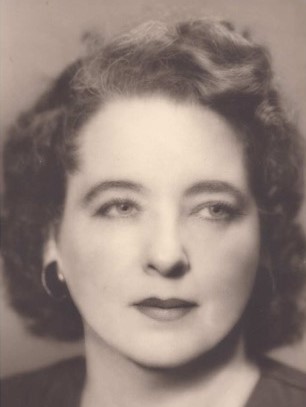
Silva Higgins
Ned cleared a lot of land in the district and beyond and also bored for water. He achieved more than most men in his days at Tenindewa. I think he eventually left Tenindewa to settle in Broome. It was with sadness that I attended Ned’s funeral at the Geraldton Cathedral. Merle, his daughter-in-law, invited us all to come up to the front of the church to join the family as there were not a lot of people who attended his funeral. A good man had gone to rest.
Politics
I remember when I hadn’t been long at Dave’s and he asked me if I would go to Mullewa with him as there was a Policy Speech for the oncoming State Election by the opposition leader ARG (Bert) Hawke. Frank Keeffe had parked his flat back truck outside the Mullewa Post Office where Bert was to give his Policy speech. There was Dave, myself and the bin attendant from the Ardingly bin on one side of the truck and Frank Keeffe on the other side. A few people wandered past but no one seemed interested. Bert started his speech and Frank started to interject and as nobody else seemed interested, the speech only lasted a few minutes. Bert got down from the truck and we stood around and talked for while. Could you imagine that happening today?
Share farming
1954 was the year I started 50/ 50 share farming. I had bought a Chamberlain 45 ka kerosene tractor (similar to that in the image below) and a fourteen disc Sunderseeder (also similar to that in image below). It turned out to be a very bad season which was quite a reality check for me as I was used to getting regular wheat payments. My brother Terry helped me by driving the tractor for my first harvest. Later I was to get an extension steering outfit for the harvester that let me drive the tractor from the harvester. After one season, I converted my harvester to power take off (PTO). This meant that I could then operate the harvester from the tractor.
In those early years we had a big problem with vermin. Leading up to harvest, Dave and I would go around the crops in Dave’s Volkswagen carrying a 303 rifle, a 22 rifle, a shot gun and an axe. We would use these to chase the emus. We were both very bad shots so we didn’t shoot very many. There would be 30 to 40 emus in a mob and they would return to the paddocks as soon as we got home. As we cleared more land the problem decreased. Dave loved his Volksy. He could go anywhere in it. He said the Volksy made a welcome change from the days when he used to get stranded in his truck.
Lifestyle change
In 1955 Jean and I decided to get married. This prompted Dave to think about a house for us. He initially thought of building a house but ended up deciding to purchase a property that was owned by Ned Higgins (prior to this by Harold Hayes) as this land came with a house. Harold Hayes was a WW1 veteran and a TPI (Totally and Permanently Incapacitated) person. He was as brave as they come. He would slave away at his farm all week and often had to go to the Mullewa Hospital for treatment for his war wounds. Buying the extra land was a great move by Dave. Jean and I then had a house and Dave had more cleared land and a bit more water. Hayes’ block was about 2 700 acres with over 1000 cleared acres.
1955 was a very wet summer with wild storms and a lot of rain- around 15 inches from memory. When Jean and I went on our honeymoon, there was water and broken branches on the road from Geraldton to Albany. When we finally returned to the farm, Paddy Butler had painted the kitchen from its original “sunshine red” (paint used for tractors) to a more suitable colour. Seeking Dave out on my return, I found him sitting on his bed with the roof of our old hut 100 metres away in a paddock (result of the wild weather). I told him he could live with us and he shifted in straight away. I am sure he appreciated Jean’s cooking and definitely it was much better than what he was used to. Jean often cooked his favourite mulligatawny stew.
Ryans block- a great purchase for the farm
It was not long before Dave had his pad and pencil out working out his budget again and he decided to buy another farm off Ned Higgins. This land, called Ryan’s, was just over the road from the house and used to be owned by another WW1 legend Jackie Ryan. In my opinion Ryan’s is the best land on the farm and it gave Dave another 2 000 acres. Jackie was ‘a wreck’ from the war. He had been gassed and had experienced other problems. He did it hard. Often he walked to and from Mullewa- a distance of 34 miles round trip. Jackie had two camps and he shifted from one to the other if he had trouble with the snakes.
Not this newly purchased land of Ryan’s entire block was cleared. You can see from the map of the farm how Dave built his empire. There was also not a drop of water on this new block- only a dry dam. Our next challenge was to clear the heavy timber and, as I have explained in another story, this was when Ned Higgins started chaining the Green block.
Dave went on holidays in 1960. Usually he would say “see you when I get back”, but not this time. He shook hands with me and kissed Jean goodbye. Unbeknownst to us at the time, this was the last we were to see of him. He was to die of a massive heart attack on his way home aged 56 yrs old; just at a time he seemed to have had everything worked out perfectly.
Surveying
Before I leave this era I would like to say how interesting it was to find the survey lines that we were required to adhere to when fencing the block. Finding the wooden peg at the end of the blocks was not so hard a feat, but it was much harder to find the half inch metal pegs spaced ten chains (approx 200 meters) apart. We used a chain measure and eventually managed to find all the pegs and fenced the block using ring lock (see image below) which was now on the market.
On my own
In the summer of 1960 Tom O’Brien, a first cousin of Dave, came out from Geraldton to help me put a fire through 300 acres of clearing on the Green block. It was a hot day with the wind in the right direction. At about 11 o’clock, we started a fire that blocked the sun out, but at the end of the day there were a lot of unburned trees. The soil around the trees was bare. There was not a blade of grass or low bush to get a good fire face, so strips were left. Tom was disappointed that he had left me so much work to do. We had done our best and kept the fire within our boundaries so I guess that was something. It was 3 years until I cropped the entire 300 acres of the 4 000 acres that we were to clear and for me to grow the best ever looking crop I ever had on Ajax.
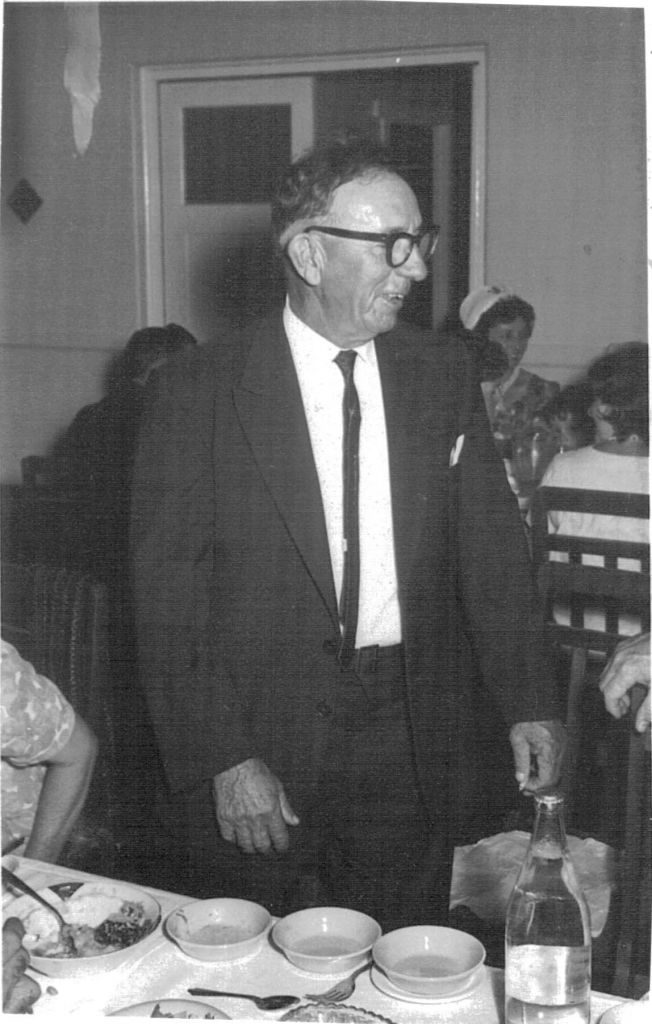
The wonderful Tom O’Brien about to make a wedding speech
After having a scare with a little rust two years previous, Gerry Throssell from the Agricultural Department advised me to grow the variety Woongoondy. I was lucky the grain was good but it only yielded 12 bushels (.8 tonne/hectare). (1 bushel is equivalent to approx 27 kg) to the acre. The rust had had its affect. At this time I had a ground drive Header and it was struggling to get the mass of straw through the machine. My father visited me in July of 1963 and said “look out for rust this year boy, its one of those years”. The season was very wet and humid.
Clete Heelan
Clete Heelan, brother of Dave, came out to manage the farm about this time and he also did a bit of wheat growing along with Len McCagh and Phillip Ullrich. My Brother Terry had cleared 800 acres for the use of the land for one year but he had trouble getting it all seeded so Clete gave him another year.
I remember Tom Foster, the Tenindewa store keeper, going around the Tenindewa district taking a census on how many acres of wheat were sown that year. It must have been for the wheat quoters. We had sown the most acres, but Kevin Critch had produced the most grain for the year.
Clete Heelan had sold his little shop on the west end beach in Geraldton after having been diagnosed with Hodgkin’s disease. He had treatment before he came to the farm and was not in very good health but he soon adjusted to farm life. He and I were to work together for the next 10 years and formed a great friendship. He was a brave man. Because of his illness he often had big sweats and had to change his bed clothes but still he turned up for work. Not long after he came to the farm he had a house built for Jean and me and our three children (or there may have been four then?). Bill Irvine from Elders Geraldton told Clete “to get the little woman some decent power so she can have a proper fridge and washing machine” so Clete came back from Geraldton with a 4 kva automatic lighting plant. This was a great improvement from the 32 volt plant that Jean often had to crank up. She often had to switch it from petrol to kerosene when it had warmed up and also had the task of cranking the engine to start it at times. This also made Jean a bit cranky at times too!
Power lines
We had to build quite a large cement block as specified by Lister to support the three cylinder engine and put the power lines over to the house which was some 200m away. This meant getting a qualified electrician from Geraldton to do the technical work prior to start-up. Imagine the difference it made to our lives being able to turn on a light switch and have the light come on in four seconds! When the last switch was turned off at the end of the night, the plant shut down. Our only problem then, was when one of the kids turned the light on in the middle of the night, and started the plant going again. We solved this by turning the main switch off at night. As we now had power we were able to then purchase 240 volt household appliances. This was great!
The shearing shed
Our next big experience was building a shearing shed. Bill Stevens, manager of Elders Geraldton, suggested to Clete that he get a new shearing shed. He advised that by doing this, he could do his own classing and he would make enough money to pay for the shed as opposed to having the clip “bulk classed” in Perth. Clete agreed to the suggestion and I well remember coming home one evening to find the material to build the shed lying on the ground where Clete proposed build it. When I asked Clete who he was getting to put the shed up, with a little laugh, he said “I thought we could put it up our selves”. I did not think I would be of much help, as I had no experience in building. He said that if I could get the trusses up, he could do the rest. I knew I could at least put the trusses up so we got Bill Irvine out and he marked the where holes were to go. We had to dig 3 ft 6 “holes through the clay and coffee rock. It was hard going. Bill came out again and gave us the levels. We put concrete footings in and then pulled up the trusses and cemented them in. Clete had a good knowledge of building but it took us a fair while to finish as we still had other jobs to do. It was just as well that we ended up with a decent shed as the sheep numbers were rising.
Shearers
The shearing was always done late March or early April by Ned Ridley. He was a steady old shearer doing about 80 sheep per day. Dave would skirt the fleeces and put them in a bin and I would come and do the pressing when required. The wool was sent to Perth for “bulk classing” as we did not have enough room to do the classing in the little shed on the farm. It was an interesting time for me listening to Dave and Ned’s life stories.
Not long after going to Dave’s, he asked me if I would clean up the old shearing shed as he was going into Mullewa to pick up Ned Ridley to do the shearing. He left on a Monday morning to go into town and he and Ned decided that they would have a drink and get a couple of bottles to take to the farm for an evening drink. One drink lead to another and Joe Wall, father of Michael Wall a Mullewa footy legend, joined Dave and Ned. Joe was related to Ned by marriage. Ned and Dave both were of Irish descent and I think this Irish blood was responsible for them deciding to have a “pre shearing party”. I waited for their return which was not to be until about midnight on Wednesday. When I arose on Thursday morning I discovered the truck parked outside. There were empty big brown bottles of beer lying on the back and I have often wondered how many bottles may have fallen off the truck on the way home. When Dave and Ned awoke, Dave threatened to put Ned on the Dog Act (ie not legally allowed to drink beer). Ned replied that he wasn’t even sure why he was at the farm as all Dave’s sheep he suggested “were mongrels“. By the end of the day, you guessed it, they opened another brown bottle. I never again saw Dave return to that way of drinking.
Ned was always early to bed but would start calling me to get the billy boiling anytime after 3 am. He would start smoking and coughing and that was the end of the night’s sleep. He was the father of two of the best shearers I have ever seen. His son Bob learnt to shear at Dave’s shed and got frustrated at times. This would lead to him the striking the sheep until one day Dave walked into the shed with a hammer and asked Bob if it would be easier to hit the sheep with the hammer. I never saw Bob hit another sheep in that farm shed. Bob went on to shear 200 plus a day.
We had some great shearers in that shed. I think Lindsay Olman and Paul Desmond were the first to shear in the new shed. The first year the shearers bought their own plant but after that we installed two electric stands and added another stand as the sheep numbers grew to 6 300. Bob Ridley shore just over 200 a day. Bob was a quiet man who just got on with the job at hand. He made shearing look easy although he perspired profusely. You could never get a better action shot of shearing than to see Bob Ridley doing the long blow on a sheep. He was poetry in motion. Bob Gellatly also shore over 200 a day but always stopped a couple of sheep short of Bob Ridley’s total for the day. Bob R (I can’t remember the name of the third man) shore a steady 150 a day from memory.
Phil Ullrich and Charlie Merritt stored the wool on trucks and trailers until we got a load and then John McPherson would come and take it to the railway for transporting to Perth. Ricky Ridley also shore at the farm. He was clean and fast and may well have been the best shearer in Australia. He would grab a sheep out of the pen and from the time he did the first blow, he had the sheep on the move. He never gave the sheep time to think about kicking as it was on the move all the time. When it went down the shute it was free from cuts and pinkish from being shorn so close to the skin. Ricky would have been talking all the time he was shearing to anyone that would listen or to the sheep if no person was around. Lindsay Olman told me recently that talking to sheep kept them quiet. One year Ricky had been on a run up north and when he finished he bought a couple of shearers and the Lone Sailor, Jon Sanders to do the classing. Jon was an interesting chap and used to go to Perth on weekends to sail. We saw Jon again at the launch of Ricky Ridley’s book (Chased but Chaste). Jon said his sailing days were over and he was only sailing short trips. I did read later though, that he had been around the world again and recently had to be saved when his yacht took water on the WA coastline. (June 2015)
I think shearers do an amazing job doing the same repetitive work for 8 hours a day and I think it is a job that requires one to be very fit.
Getting water
Water was the biggest worry at the farm. When poly pipe came on the market, Clete decided to pump the water around the farm. We asked Bill Irvine from Elders Geraldton to take levels and tell us what was needed. We used an 1 ¼” poly pipes to pump the water to tanks put in by Branko Koric in central points on the farm. The water supply was still limited so Clete decided to put a bore down near the government bore which was very close to Hayes boundary. This gave us a very good supply of almost drinkable water. We piped this to connect with the existing line. What a difference it was to not have to worry about water as we only needed drinking water for cooking.
We could now abandon the salty bore on McRoberts. As it was equipped with a mill with a 14 ft wheel and 30 ft tower, Clete was keen to have it moved to the house so we could use it for pumping the water around. I said that I would put it on the back of my old KB5 inter truck and shift it. Clete laughed at first and then thought maybe it was worth a go, so we put solid 44 drums behind the cab and a few sleepers to rest the tower on. We lowered the mill down gently onto the truck. The tower legs cleared the ground by a couple of feet so I drove the truck 4 mile home at walking pace and we erected it on the new site. That was the end of water problems on Ajax!
I remember we had nearly lost the use of the McRoberts bore a few years earlier when it stopped pumping. The bore was fitted with 2 ½ inch pipe and a 2 ¼ inch pump. You could pull the plunger out of the pump by just pulling the wooden rods and replacing the buckets. To try and fix the problem, we pulled out the plunger, only to find the buckets were in good condition. We then decided it had to be a fault with the pipes. When we pulled out the pipes, we found that the pump had come off the pipe and was still down the bore. The pump and tail pipe would have been 6 ft down and if we couldn’t retrieve the pump, the bore was useless. We decided to go home to think about what we could do. I came up with a brainwave which saw me fit 2 new leather buckets on the plunger. I would then lower these down the bore by hand, using only the rods. When we felt the plunger rest on top of the pump, we gave it a little jiggle which slid it down to the bottom of the pump. We left it for 24 hours so the buckets would swell. It worked! Imagine our relief when we pulled the rods up the next day to see the pump attached. It’s a silly little story really, but it meant we could still use the bore. Pulling the pipes out of these bores was a very strenuous job. They were very heavy and it was mainly summer when we pulled them so they were also very hot. We had to use pipe tongs with a handle about 3feet long and this often didn’t give enough purchase so we had to slide a piece of pipe over them to give more leverage. It could also be quite a dangerous as one had to rely on the other person to do the right thing. A wrong move could have seen a pipe falling on the other person’s head.
Jean
I must mention the effort my wife Jean put in on the farm. She was only just 20 yrs old when we got married. She had been working for Fred Lewis in a grocery shop serving people every day so coming to the farm was a very different life. There were no close neighbours and we did not have a phone. She was the only woman around and it would have been a lonely life. Luckily she was a good driver. She had never had an infringement of any kind or an accident in all the years she drove. Sometimes she would visit her Mum or my sister Mel Weir to cheer her herself up.
Jean was always a good riser. She would jump out of bed early, put the washing on, get the kids ready for school and cook for the shearers at shearing time. When we were busy on the farm, she would go around the water run and clean the troughs and make sure the mill was pumping. She would let me know if there was enough water in the tank for the sheep and if they looked content. She would make sure all the gates were closed and that there were no stray sheep anywhere. She was always there to help me shift the plant when required. Jean also did marking for the spray planes on a couple of occasions. On one occasion she got sprayed with 2/4d Esther when she forgot that the sprayers usually did one last fly over across the paddock and she was still on the paddock at the time!
Jean’s parents were Bill and Mary Evans. I was weak at the knees when I asked Bill for Jean’s hand in marriage and was glad when I got the ‘yes’ word. Bill was a Victorian who had come from Wonthaggi to Mullewa as a 20 yr old. After Bill and Mary married, I believe Bill worked for a Captain Gee VC who had a farm at Woogoondy. He also went droving with his brother–in-law Joe Criddle up north to the station country. These droving trips took considerable time. The men walked the sheep to Mullewa where they were loaded on a train and taken to Fremantle. Bill took care of the sheep on the train trip, watering and feeding them as best he could. On one occasion, after he had delivered the sheep to the authority at Fremantle, Bill took advantage of some leisure time by walking to the Subiaco footy ground and watched the 1926 Grand Final. Bill was fond of sport and often rolled cigarettes to help him stay awake so he could listen to the sport on the Radio. He played footy with the Devils Creek Footy club until he was 43 yrs old. He reasoned that he retired at this age as his toe nails had started to drop off. He also worked for the WA Government Railways with my brother-in-law’s (Rob Weir) father who was the ganger responsible for maintaining the rail line at Tenindewa. Bill later worked in his trade as a butcher for A F Bowtell & Sons who were butchers and big landowners in Mullewa. Bill came out to the farm whenever he could until he retired to give me a hand. This help guaranteed that he was a mate of mine for life.
Mary Evans (Jean’s Mum) nee Criddle, came from a family of three boys and five girls. Her family lived on a farm between the Pindar and Morowa rail lines which was about 3 miles east of the Mullewa bin. I think the depression drove them off the farm and they started a boarding house which was situated on the left side of the road leading into Mullewa. The girls worked there for many years, only leaving as they married. Mary stayed at home to raise her children and was a lovely caring Mum and later Nana to her Grand children. I remember her giving me a hot three course midday meal just before I tried to play footy. We all remember her with pride.
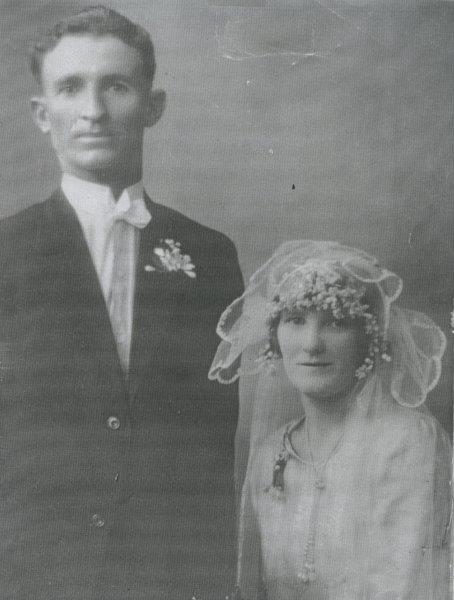
Jo and Mary on their wedding day
Farm life for the kids
The kids were a help especially as they were all able to drive by the time they were 10 or 11 or even younger. When the kids started school, Jean had to take them 4 miles to Dunkin’s place. This was time consuming and she had to be there every school day to pick them up as there were no phones to change plans. As time went by, the school bus route was extended another 2 miles. This did not help us very much as Jean still had to drive to meet the bus. Later it was extended to Jim Du Bouley’s place. This was great for us as the kids could now walk home the ½ mile from the main road.
School bus drivers
I remember most of the bus drivers from those days- Paddy and Pam Barden, Maurice and Eileen Fienberg, Kevin Bisby and Bert Rowe. Bert was late getting back to the Bowling Club for his afternoon drink one day and when he was asked why he was late, he told his mates that he ‘had to change a flat tyre’. His mates teased him saying that ‘he wouldn’t know how to change a tyre’ and he admitted that this was true. He went on to say that “one of those nagging Cream girls talked him through it”, “ Chock one of the wheels Mr Rowe and put something under the jack or it will sink in the ground” and “Dad said that if you loosen the wheel studs before you jack up the bus it makes it easier”. Bert shared that he answered the ‘Cream girl” by saying “if her Dad was so clever why didn’t she go and get him”. The chap that told me the story said that later Bert had told him he was very pleased that he had got the kids home safe and sound. Bert was a character in Mullewa having run the TAB for quite a while and operated the Mullewa Wheat Bin.
Golfing days
Jean began playing golf when she no longer had to meet the bus at the farm and the lovely ladies at the Mullewa golf club welcomed her and helped her become a handy golfer. The social life went up a notch as the ladies used to perform entertaining plays and acts for the golfing audience. Who could forget the postmaster Ron Bell riding around in the club house on a motor bike with Carol Moore in the sidecar doing her Aunty Jack impersonation? “The Seven Dwarfs” was another memorable act which involved some of the ladies painting faces on their stomachs and covering their upper bodies with tall hats making them look very small indeed.
Shopping at Tenindewa Store and Geraldton
Jean went to the Tenindewa store to do the food shopping in those days. She would write out her order and give it to Nell or Tom Foster and they would put the order together for her and chatted to her at the same time. Jean sometimes had to go to Geraldton on errands for myself or the farm. I think she played her part well in the running of the farm.
Bloody roots
Things were getting easier on the farm once the land was cleared apart from ridding the land of the mallee roots. I well remember ploughing up a 200 hundred acre section of the Green block and spending the next six days carting the wood off before we could get back to plant seed on it.
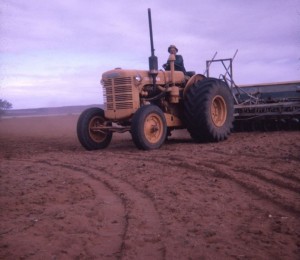 Years see things get easier
Years see things get easier
I remember that it was hard going in those days. The super was in the shearing shed and it was a long haul dragging the bags from the back pens of the shearing shed out to the truck parked outside. Eventually things got easier as I was now using bulk equipment. I found I no longer needed to lump 180 lb bags of seed and super which was great as I only weighed 150 lb myself.
I also improved my labour by using 2 x 24 row combines for seeding. This was a bit better than the 10 disc sunderseeder I started with which only cut 5’ 6”. (A Sunderseeder was a plough with a wooden box divided to take wheat in the front section and fertilizer in the rear. Underneath they had distributors to metre out the grain and fertilizer at a set rate. This bought the fertilizer and wheat together and it went down tubes to the front of each disc. The drive was by flat steel chains driven from a cog on the rear land wheel. The drive chain often came off when it hit a stump or was flicked off by a stick and you would have to walk back and find it. (No warning lights those days)
Tenindewa legend Harry Stokes told me when he started he only had a 3 furrow plough and he ploughed around the paddock all day and still hit the same stump. I felt only a bit better off than him.
Wheat grading
Wheat grading was a job I didn’t like much- standing, dragging and tipping the bagged wheat into the hopper of a wheat grading/cleaning machine- for 16 hrs a day. The machine was only able to grade 260 bags a day which seemed a small outcome for such a long day.
Laurie Williams, with his little Chev truck with the big Hannaford grader on it, was the first operator I had anything to do with. I think the front wheels of the truck nearly came off the ground when he got out of the cab.
The next operator I met was a little Hungarian man whose name I can’t remember. I don’t think I could pronounce it, even if I did. He called in on his way to do Ned Higgins grading one day and said he would be at our place as soon as he finished at Ned’s. When he got to Ned’s, he asked Ned if he could put in some extra hours to help out with his schedule. Ned said that ‘he could do better than that; they would work around the clock’. All went well until the man tipping the bags into the hopper at the back went to sleep and the bag went up the elevator damaging it so bad that they had to get a new one sent up from Perth. The Hungarian man did not make it back to our place for two days.
And who could forget big Jim Maroney in his Bedford truck. Clete’s wife Pat was to get Jims’ lunch as Jean was away for the day. When she saw him coming with blue pickle (powder used to protect the wheat from weevils and similar that was put in with the wheat at grading time) from his finger nails to above his elbows, she called out to Jim ‘there was soap and a towel in the laundry ready for him to have a wash’. He kept walking and said “I have had a bloody wash woman”. That evening he told us he lived in North Perth. He enjoyed living there and often took ‘the wife’ to church at the Redemptorist Monastery. He said that they “got a bloody good sermon and they didn’t take the plate around”. He was a memorable man.
RIP Clete
In January 1972, on the first day of shearing and before the first sheep was being shorn, Clete came to the door of the shed and told me that he had had ‘a very bad night’ and could not ‘carry on’. I knew that he had experienced many bad nights over the previous 10 years and this one was serious. He had to go to Perth to see his specialist immediately. He drove himself down in his Ute and went in to see his doctor only to be told that ‘he could do no more for him’. Devastated, Clete walked out hardly remembering where he had parked his ute and drove to his brother Stan’s place at Maddington. Stan’s doctor ‘patched Clete up enough’ to drive back to St John’s hospital in Geraldton where he died shortly after. He had survived the battle field in Bougainville in WW2 using a hand grenade only to lose his life to a blood disease at 52. However, one would have to wonder how much the war contributed to his ill health especially as he was wounded with shrapnel in very close quarters to the enemy. Ajax had lost a great manager and I had lost a great workmate and friend.
McRoberts Family
In 1975 a lady pulled up at the shearing shed and told me she was the daughter of the original McRobert’s family. She said she was looking for the house that they had lived in years before. I think I was as excited as she was and it was a pity I didn’t have more time to spend with her. We were shearing at the time and I couldn’t be away from the shed for too long. I was only too happy to take her to the exact spot and it brought tears to my eyes to see her fossicking around finding bits of old jugs, cups and saucers etc. She was so thrilled to wander around and look at where they had played as kids. At that time she lived on the banks of the Murray River, far away from the banks of the Greenough. She was content to go home after one last look. It had been a memorable day one that I will never forget. Her brother Jim also visited the site just a few years ago and I went with him and his family to his old farm block that Neil McCartney now owns. Neil took Jim for a great tour of the block. I think Jim was 84 yrs old at the time. He had left the farm some 76 years earlier when he was 8 yrs old. He told me the reason they had left the farm. They were having a battle with the depression and poor wheat prices and in the finish they were burnt out. He told me about the Aborigines who used to visit Noondamurra Pool at Christmas time and about a fire which got away from them and went up the river to their place. He also explained how the road they followed when going Geraldton was a little south west of Byron Road which would have come out at Johnson’s bore. Jim’s family home was on block 6069 on the river where the block meets 6074. It turned out that the land I was clearing at that time was land they had cropped. This explained why the blue lupins appeared when I disturbed the soil. It humbled me to think how hard the times were compared to mine..
The day Jim visited, we drove back from the farm through Yuna (which was experiencing a severe drought at the time) and had lunch at the Chapman Valley Hotel. Surely the Mc Roberts must rate high in the pioneers of north Tenindewa.
Neil and Brien McCartney
Neil and Brien McCartney own Ajax now. As nephews of Dave, I remember them as 6 and 7 yr olds coming from Geraldton to holiday with their Aunty Nell Foster at the store. Dave would then bring them out to the farm for a day, feeding them on luncheon beef rice biscuits and American Cream Soda. When they eventually lived and owned Ajax they were young men keen to be at the beginning of a new stage in farming- minimum till, even though the machines weren’t available then. Of course, it was not long before the machines were available and these new ideas of minimum till and new machines were to change farming forever.
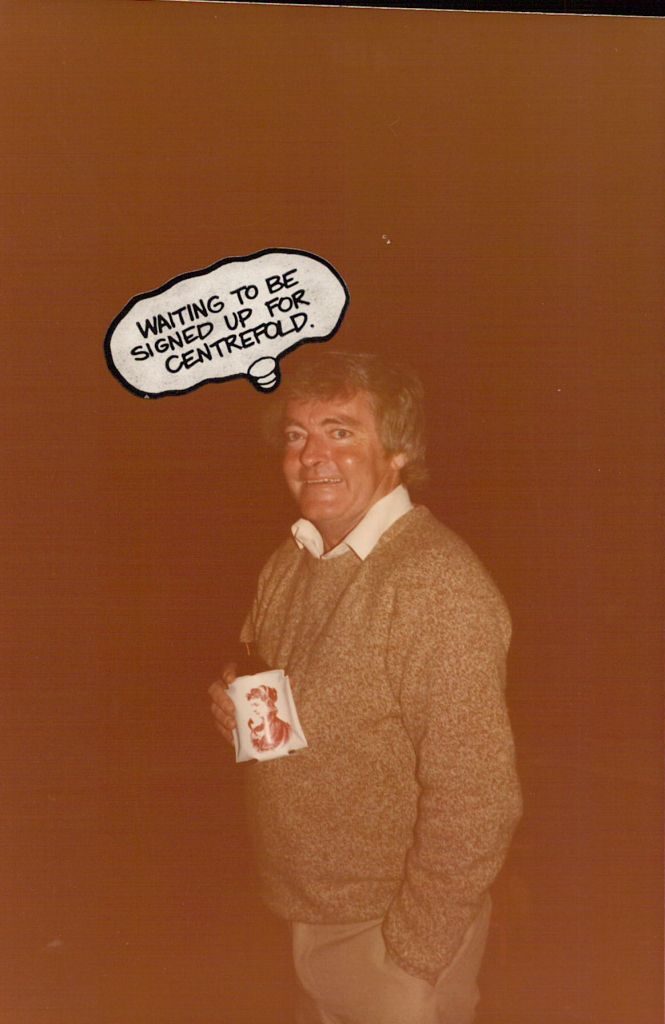
Neil as he was in 1985 at the Closing of the Store event. The caption (above) suits him
Progress
How impressive are the big airseeders and four wheel self steer tractors that are used now. Vince Mc Guinness, a cousin of Dave’s, predicted in the 1950’s that tractors would steer themselves with a flick of a switch. How right he was. This was to be the biggest change in farming in my life. Two fills of the seed compartment using these machines would have completed my first crop.
I have seen farming progress from the time I started driving seven horses abreast, pulling a 10 disc plough to the early machines mentioned in this story to the modern plant on the family farm actually doing the first minimum till. Now I am retired I think of how much easier this farming game is when you don’t have to worry about costs or organizing the show nonetheless, I had a really good time.
Crop rotation
When I first started at Ajax, we rotated the crop planting- One year in crop, two years out. Wheat varieties were not as good as today. Bungulla (a variety of wheat) was susceptive to strong winds and would fall over and become tangled. I bought a Sunshine Header off Vince McGuiness one year as I had a badly damaged crop. He said it would pick up the fallen crop but advised me “don’t go too low or you might pick-up a boxful of kangaroo tracks”. Vince always had a humorous one liner.
Closing the gate
When it came changing my farming ways to minimum till at Ajax, I felt I didn’t have the energy or the money to start again. I scratched around for a few years and survived the 1976 drought but I didn’t have the enthusiasm anymore. It was time to move on. Jean and I worked very hard at the farm and raised a family of 7 children. We managed to send them to boarding school in Geraldton and give them the education we never had. They have done well in life and that is all a parent could ask.
I felt that I was very lucky on the farm working a lot by myself and never having an accident or losing a fire despite all the big burns we had over the years. Together with my family, I have fond memories of the good times we had at Tenindewa –tennis, dances and the Christmas Trees and seeing the Tenindewa football team in action when I was very young and living at Eradu. I am sure as I closed the gate for the last time at Ajax, Dave would have said “you did alright Bloke” – a name he had addressed me by many times. I hope he never regretted the hand shake on the share farming agreement at the Tenindewa Christmas tree function all those years ago. I will be ever thankful to Dave Heelan for giving me a start at farming.
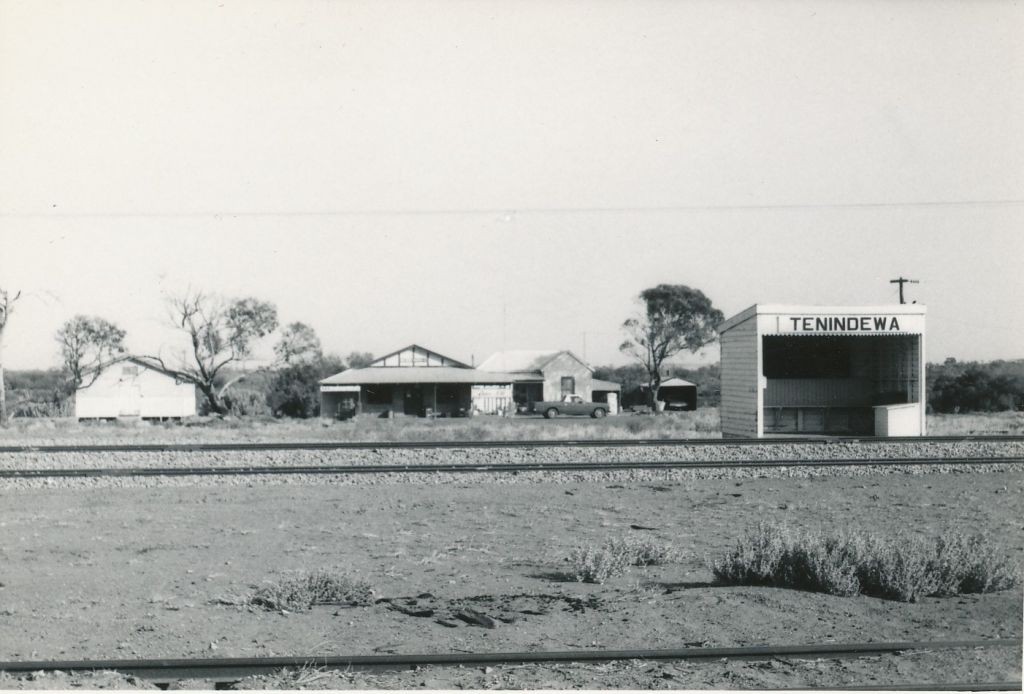
Tenindewa Rail Siding taken 8 January 1977. And the Hall where it all started
Post Script
Sadly Jean passed away on 9th of November 2021
The following appeared in the Obituaries on the 10th of November 2021
“The Tenindewa Community acknowledges with great sorrow the passing of our much loved and celebrated musician. Jean generously, lovingly and enthusiastically entertained and accompanied hundreds of social (especially children’s) events over many decades throughout the Mullewa district. She was a district darling”.

>>>>>>>>>>>>>>>>>>>>>>>>>>>>>>>>>>>>>>>>>>>>>>>>>>>>>>>>>>>>>>>>>>>>>>>>>>>>>>>>>>>>>>>>>>>>>>>>
Albert passed away peacefully in January 2024
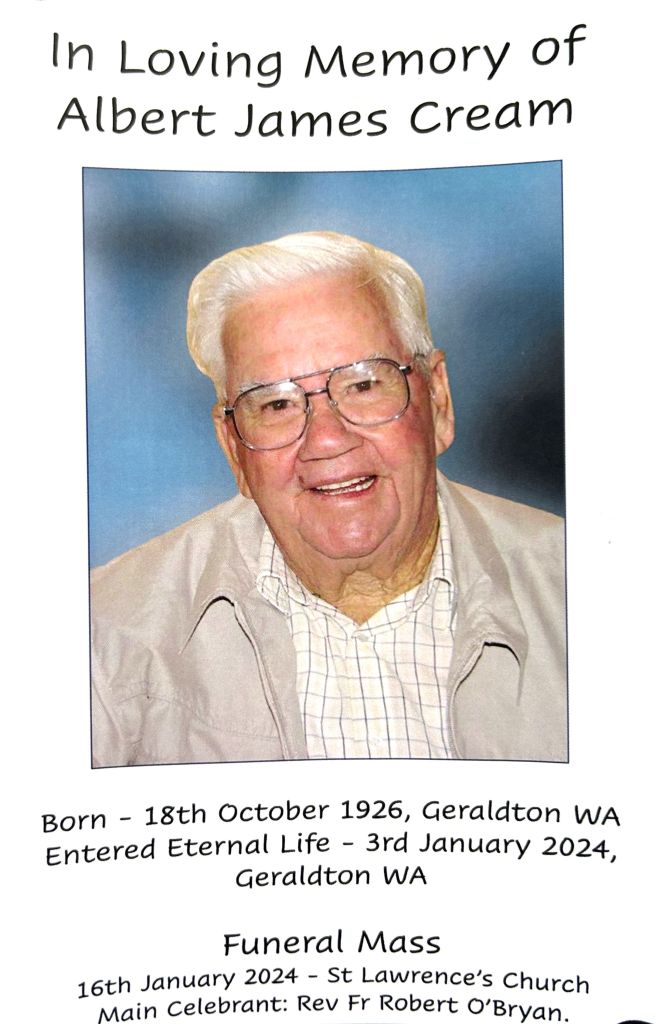
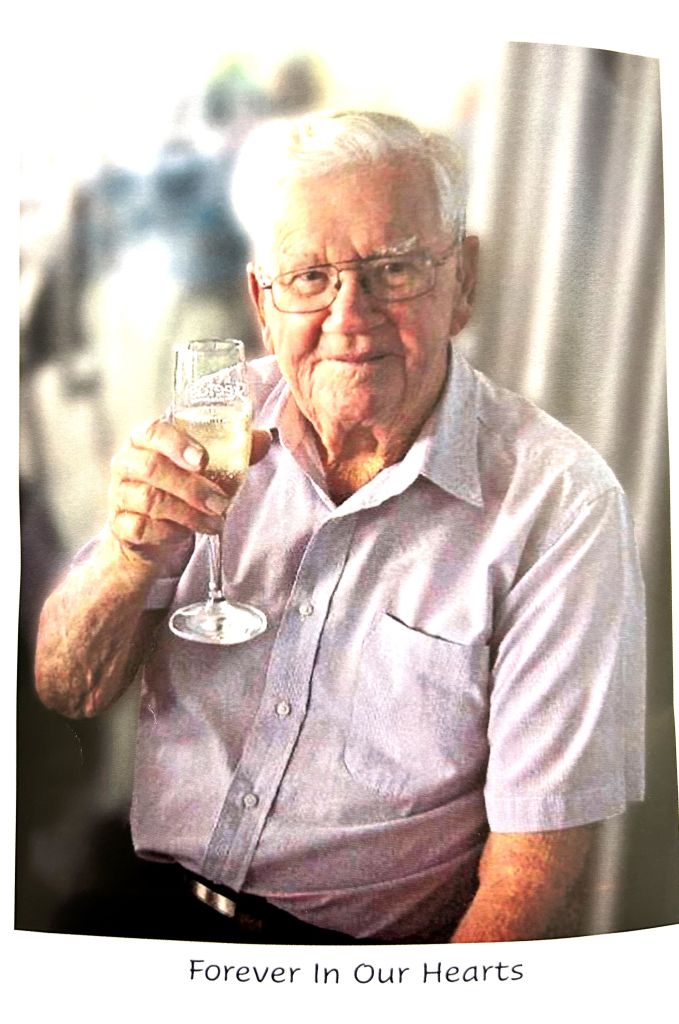
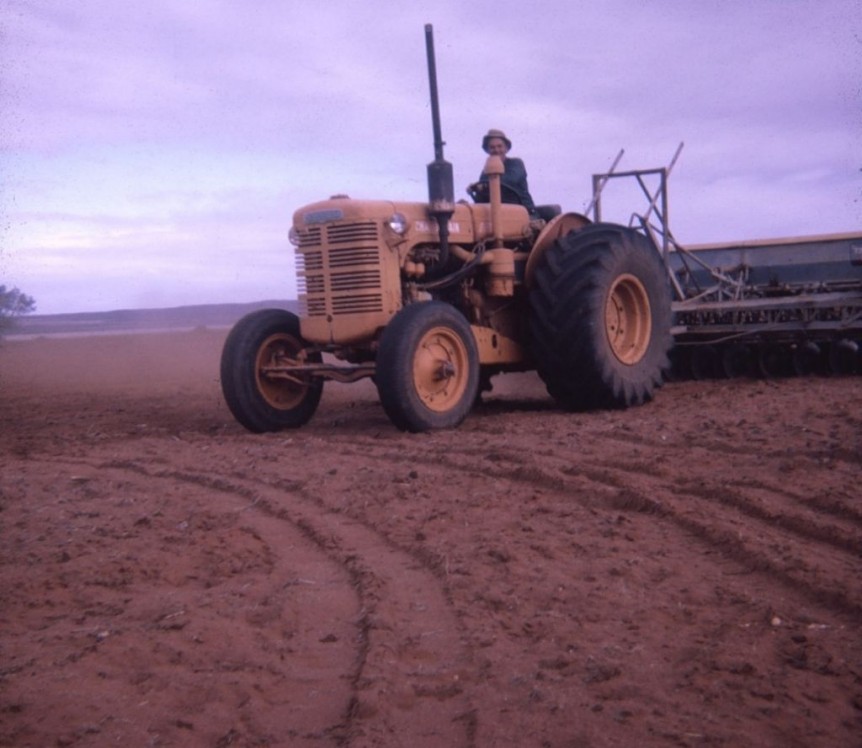
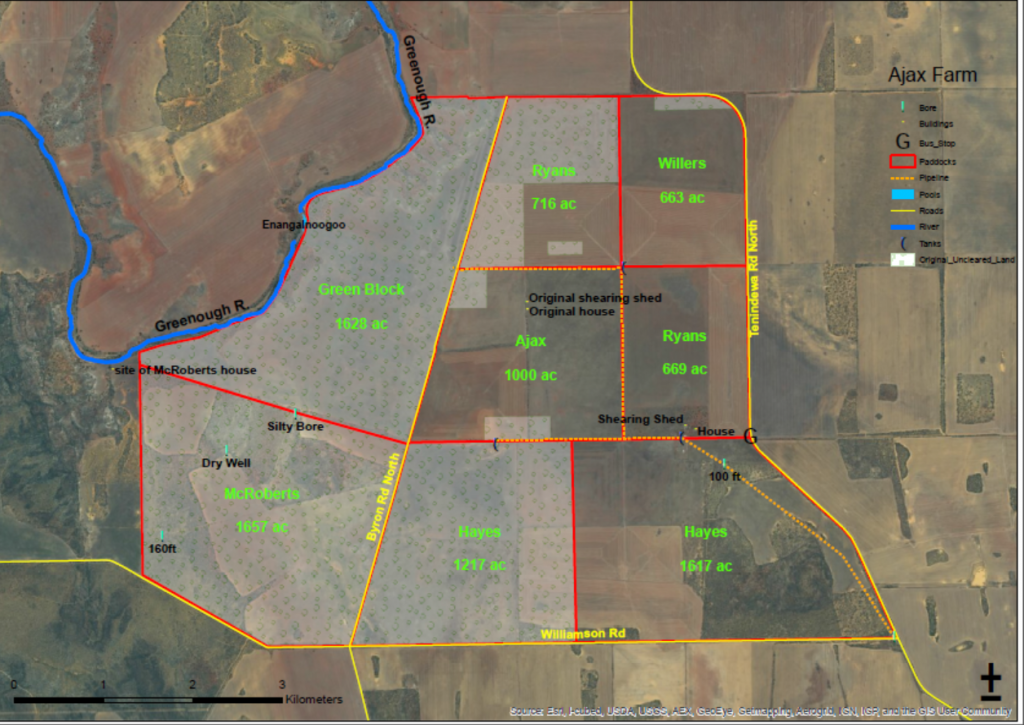
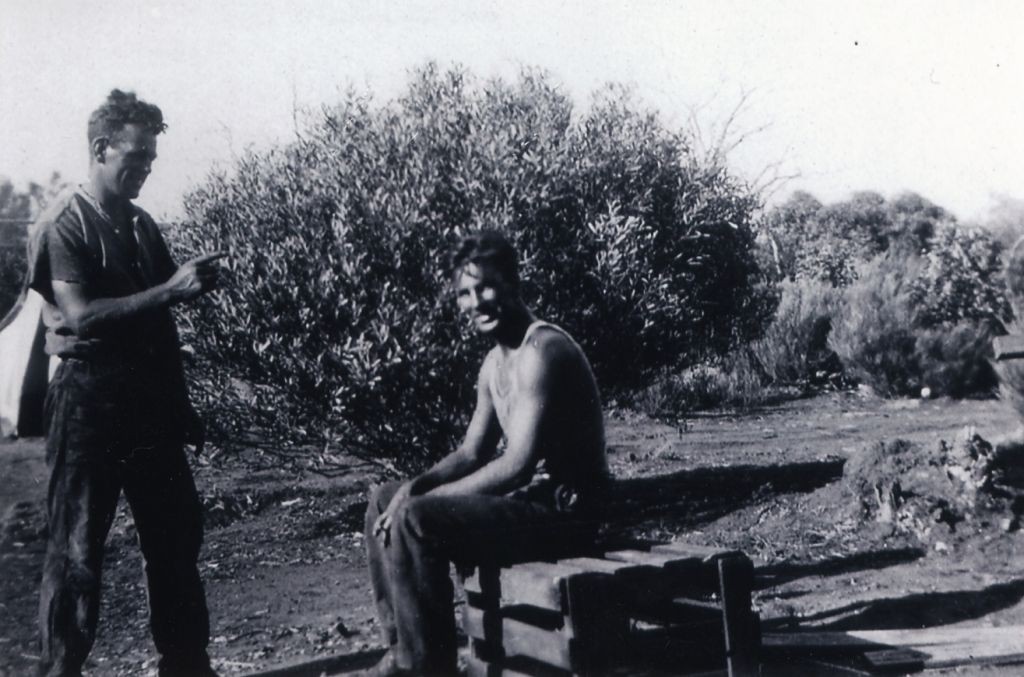
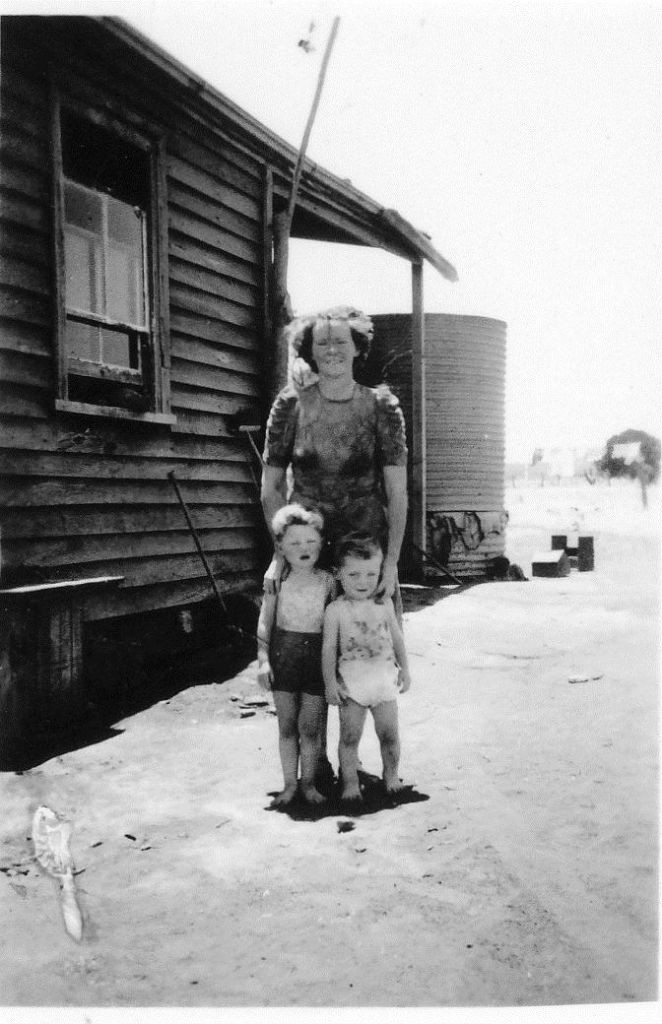
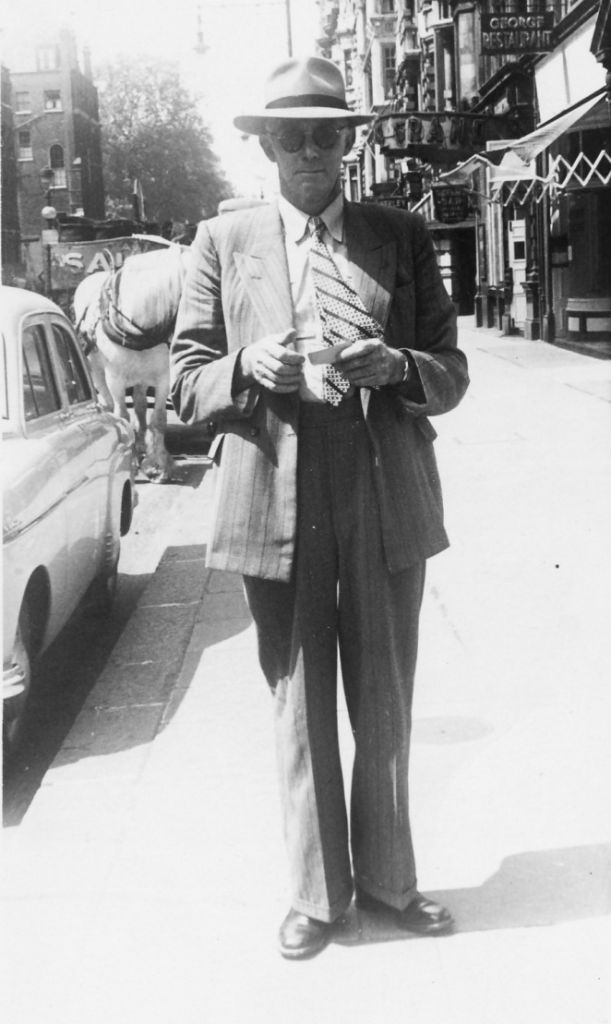
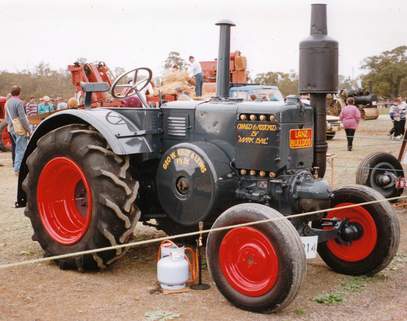
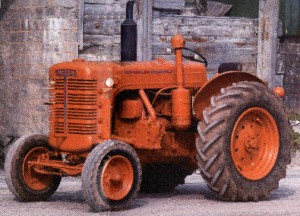
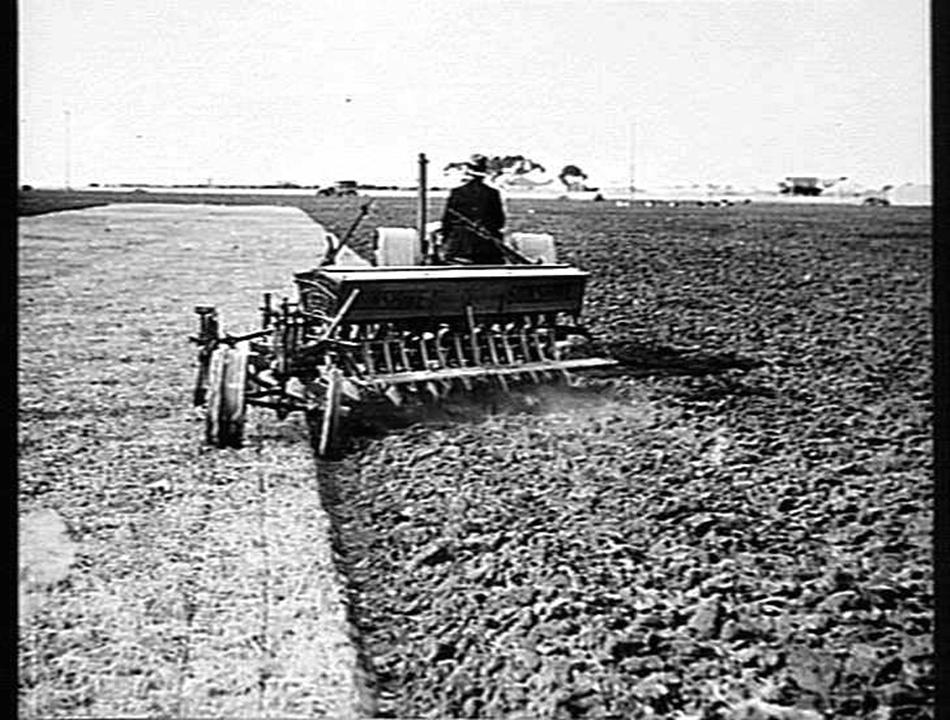
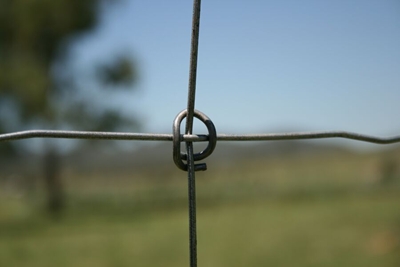
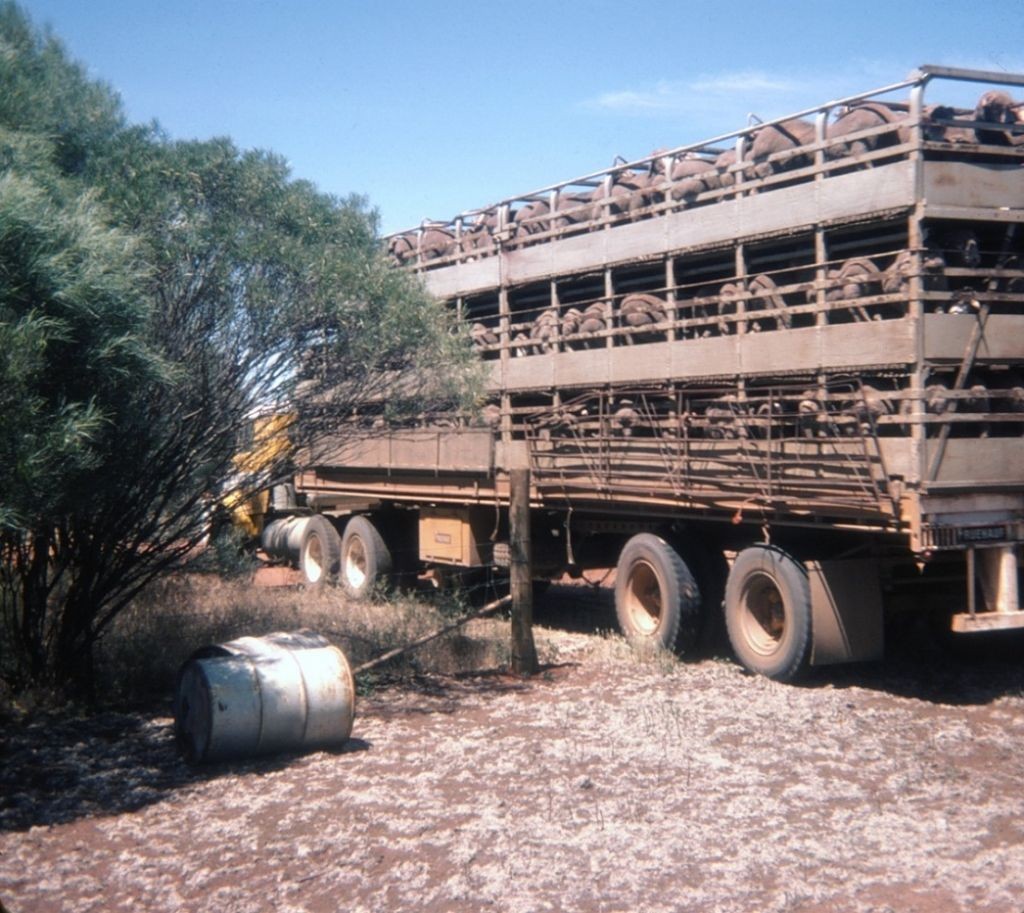
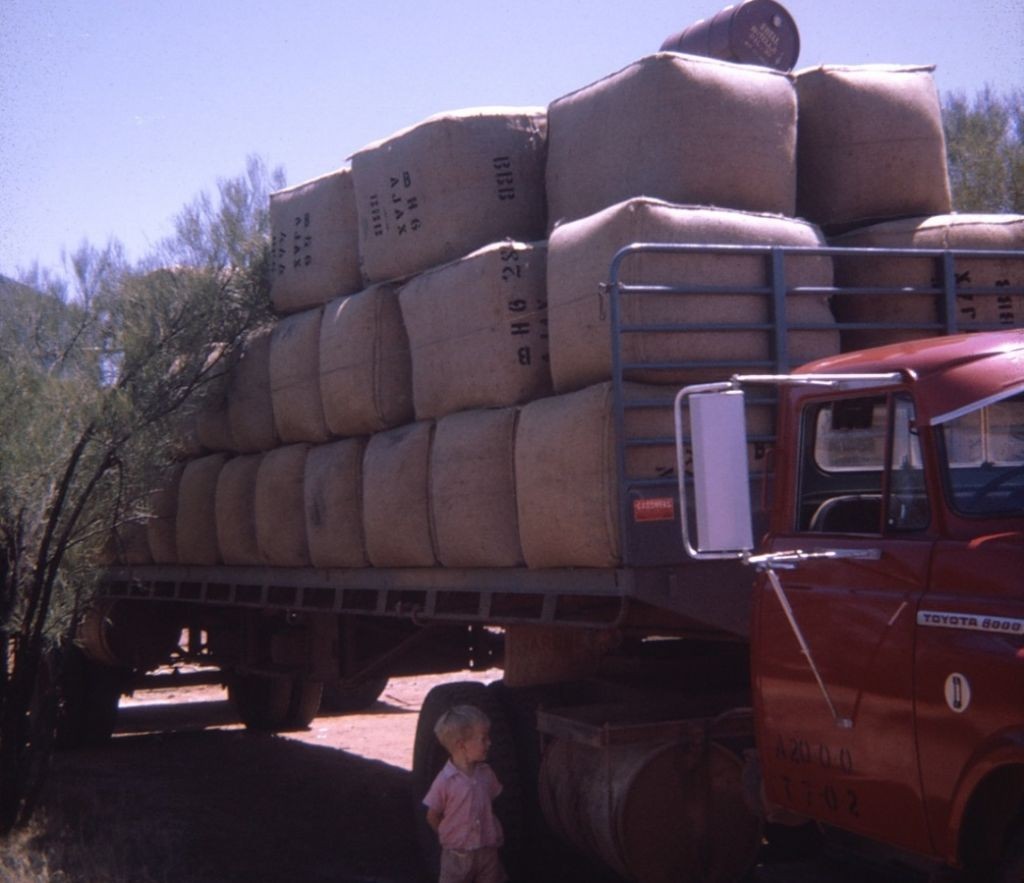
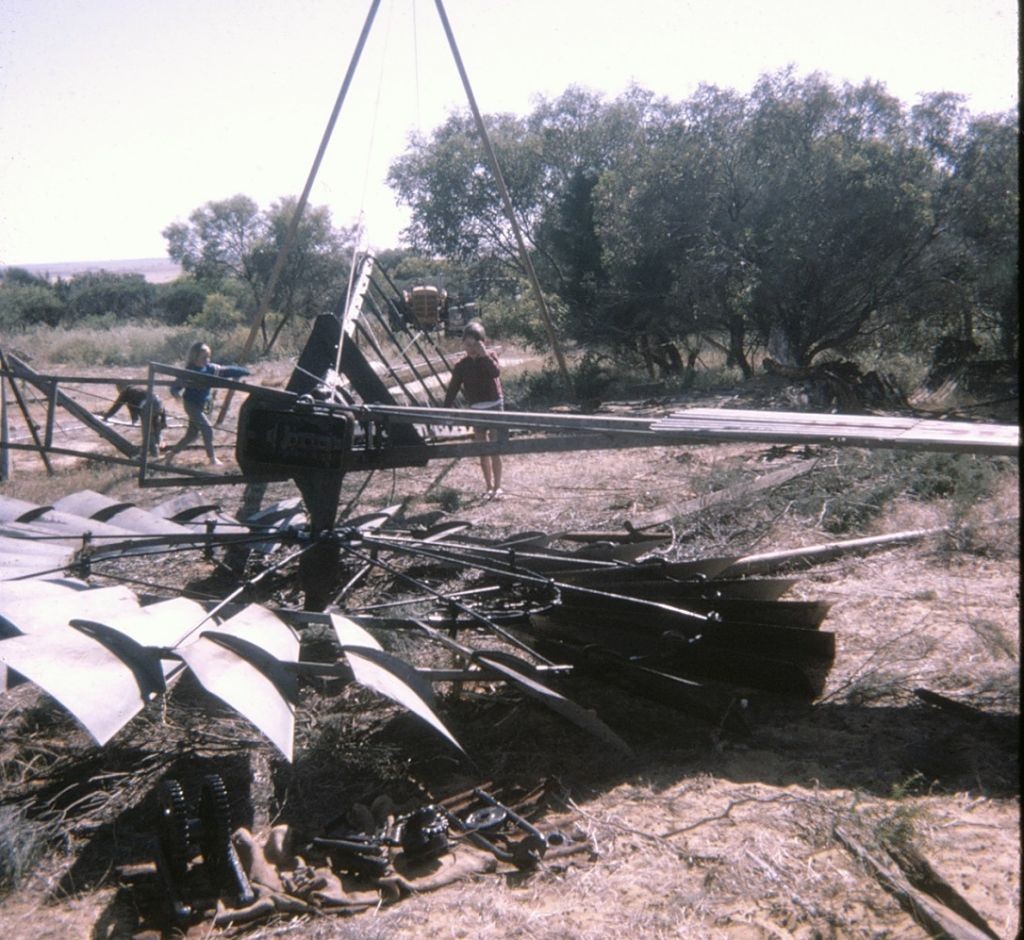
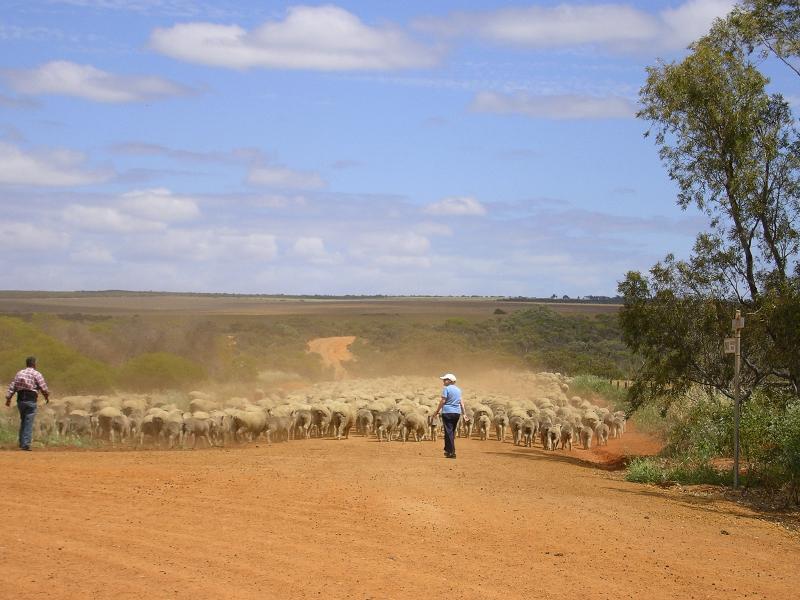
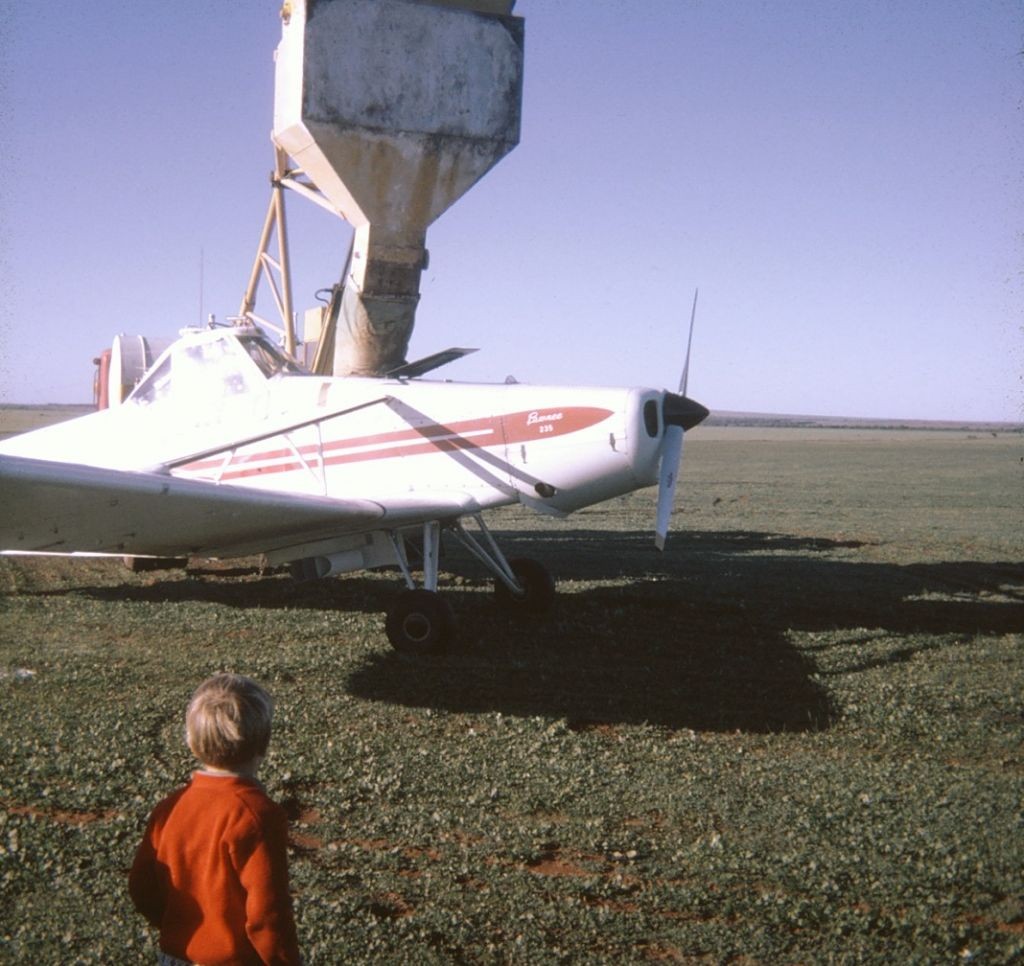
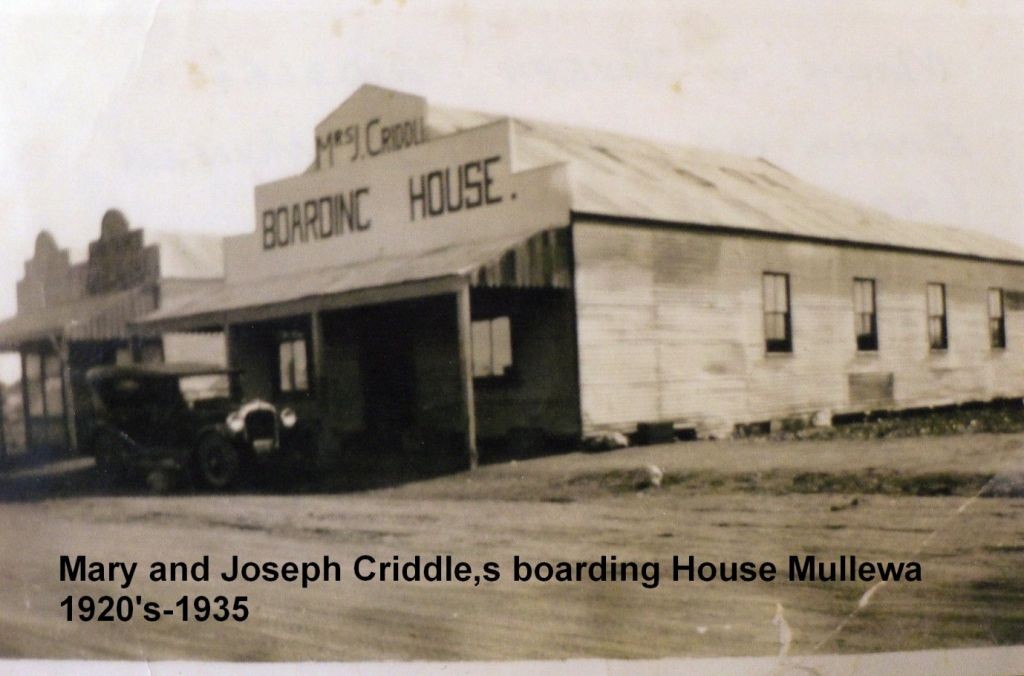
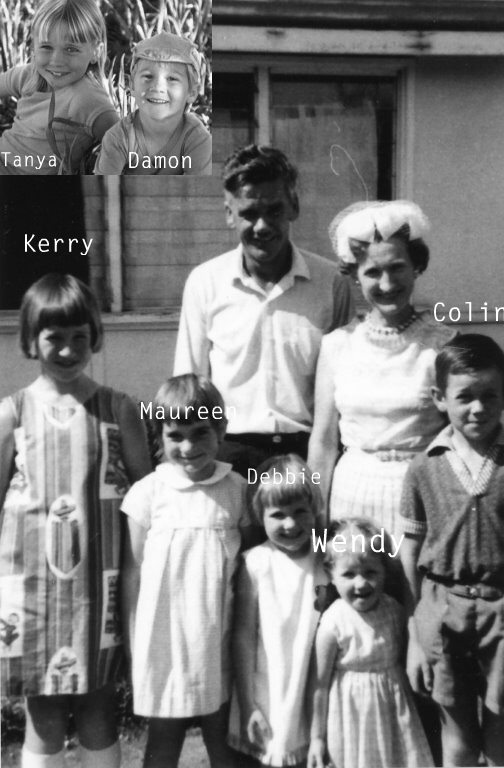
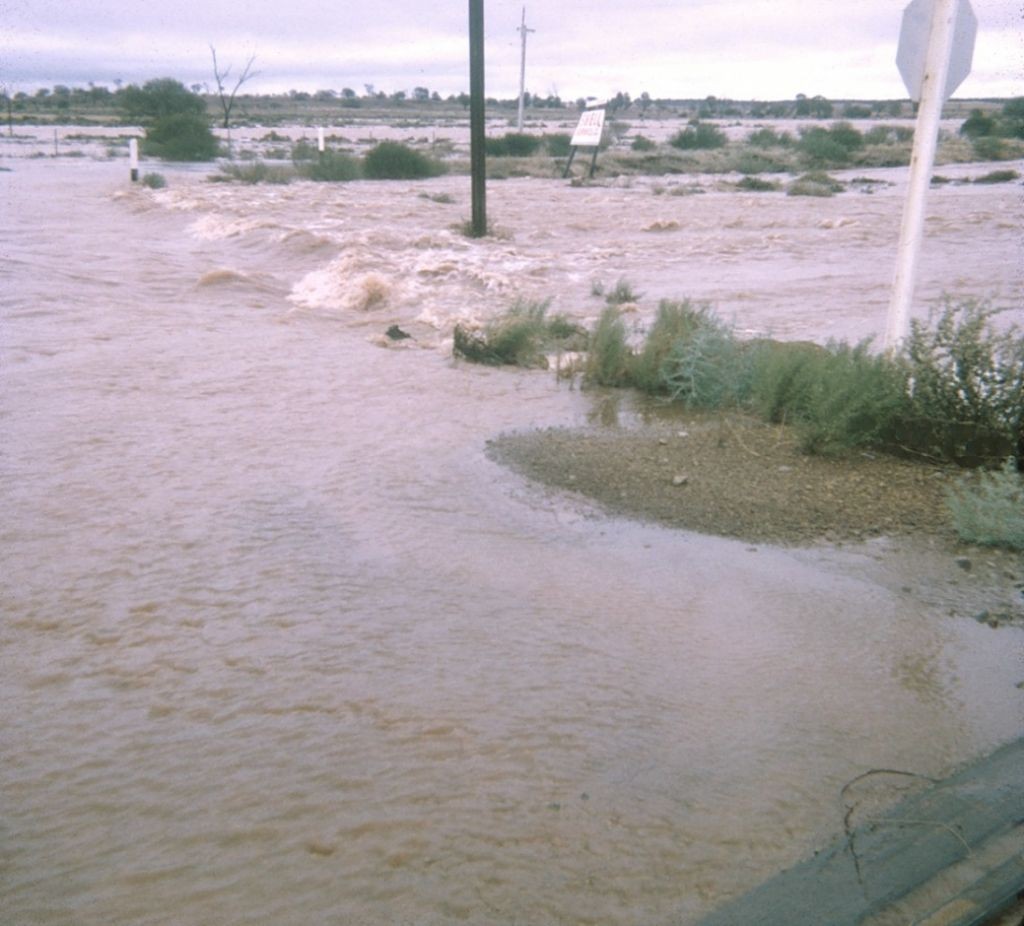
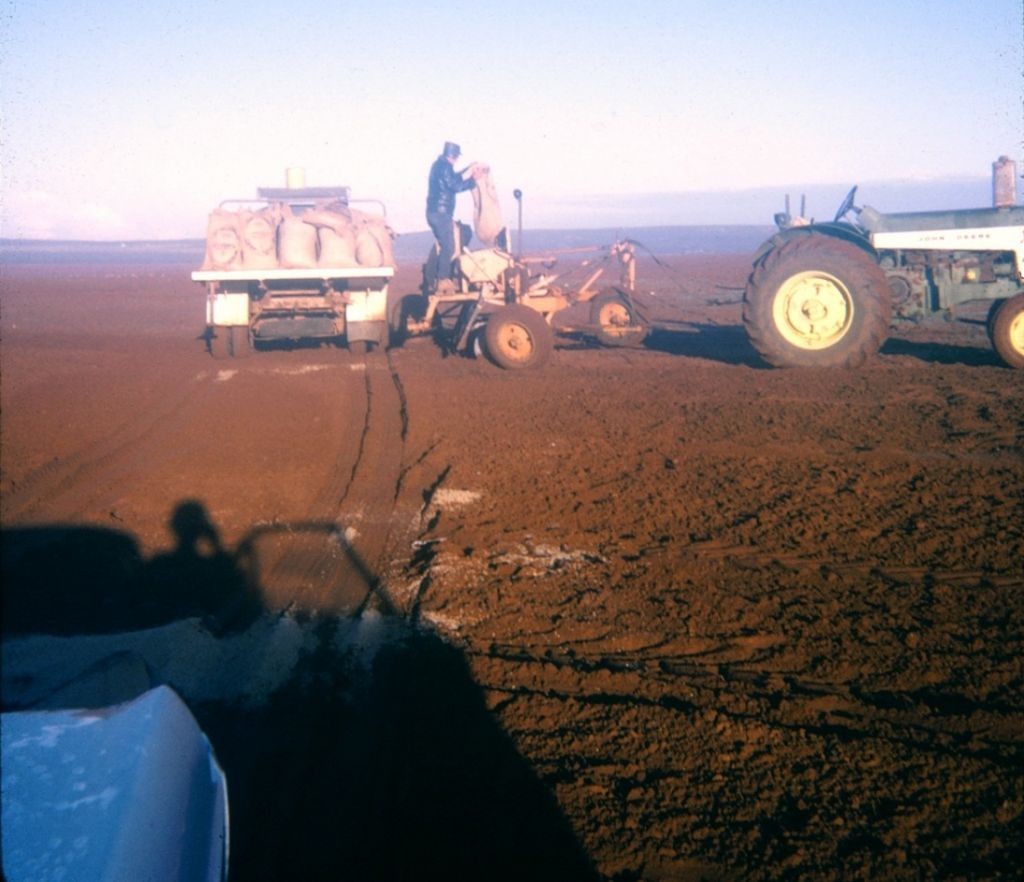
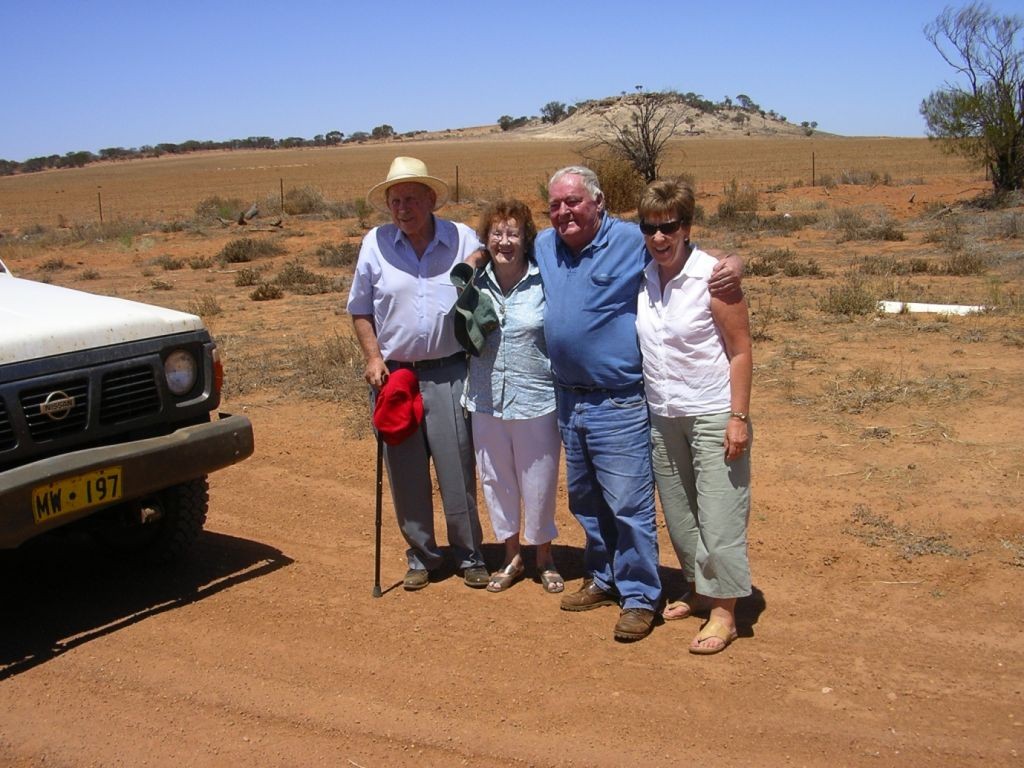
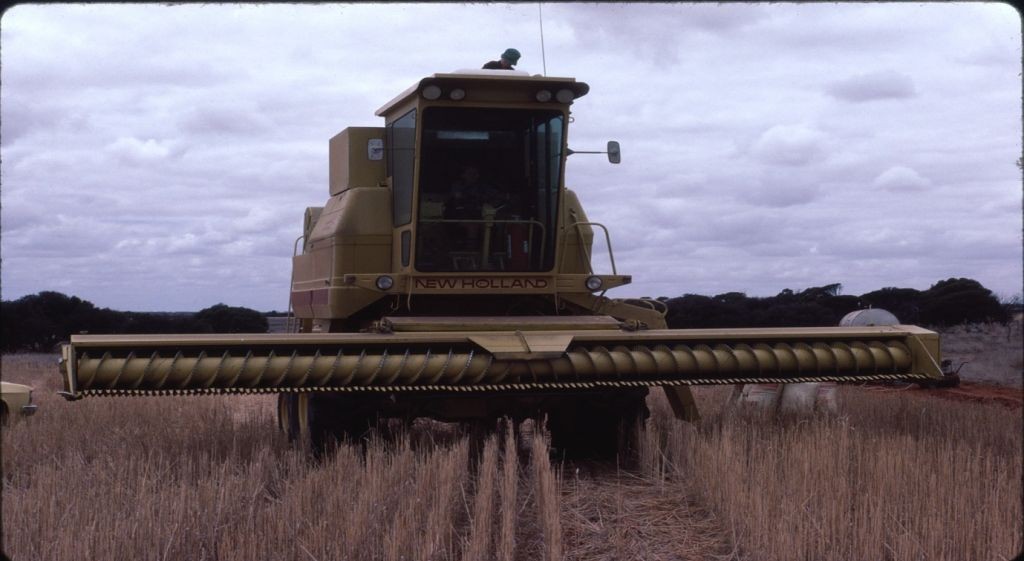
Comments
Wow! What an epic read Pop! And fascinating too, to see how the times have changed and how you adapted to it all. Even till today with the sharing of your story on here.
I truly do admire your hard work now more than ever, as we can now appreciate the ingenuity and determination required to be a farmer when you first started out. And Nanna too!
Amazing. Loved it!
kx
When Wendy first told me you were writing your story I couldn’t wait to read it. What an amazing story of your and Jean’s life together, from starting out to getting married and raising 7 kids! I sat chuckling to myself through parts and imagined the heart ache you would have felt at times. Thank you for sharing your story, it was like stepping back in time, I recon I could sit and listen to you yarning about the old days for hours and hours.
What an interesting life! Well done,Albert.
Thank you Albert for an insight into yours & your families lives. I can only imagine the daily life back then & not even begin to think how much harder it would have been for your parents & earlier families.
I’ve only known you for the few years that your youngest brother Terry & I have been together so it was especially nice to not only read-up on you young fellas but to see you (photographically) as well.
Its been an eye as well as mind-opening experience for someone of my generation to learn about farming & family life over here in those early years – thank you! xLyne
A great read I still do some work in that area with the Department